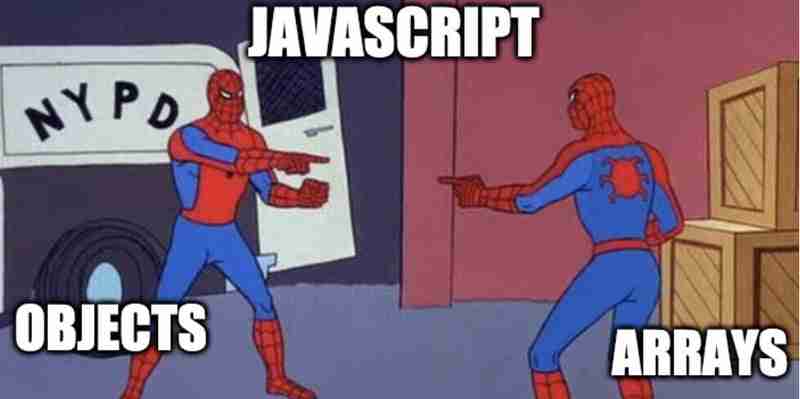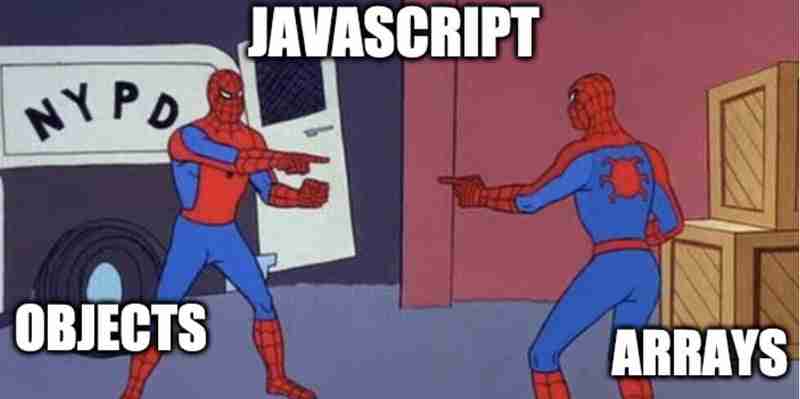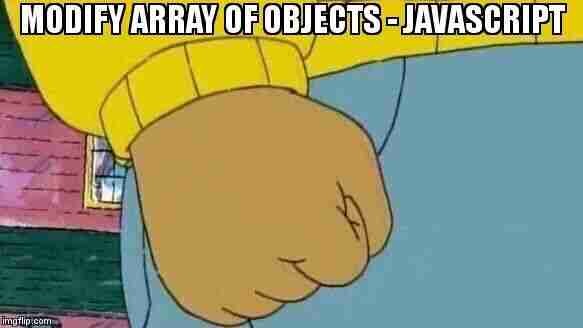जावास्क्रिप्ट में ऑब्जेक्ट और ऐरे

ऐरे और ऑब्जेक्ट जटिल डेटा-प्रकार हैं, जो अपने आदिम समकक्षों के विपरीत, एक साथ कई मान रखने में सक्षम हैं।
आप स्वयं से पूछ सकते हैं कि इस कार्य को पूरा करने के लिए किसी को 2 जटिल डेटाटाइप की आवश्यकता क्यों होनी चाहिए, यह प्रश्न करते हुए कि कार्य पूरा करने के लिए एक का होना पर्याप्त क्यों नहीं है। आपकी स्थितियों और उद्देश्यों के आधार पर, आपके लिए एक "एरे" पर एकाधिक मान रखने के लिए "ऑब्जेक्ट" का उपयोग करना बेहतर हो सकता है, और इसके पीछे का तर्क एक कारण से आता है: पठनीयता। ऐसी परिस्थितियाँ हैं जिनमें आपके लिए किसी सरणी के स्थान पर किसी ऑब्जेक्ट को चुनना बेहतर होगा, और इसके विपरीत।
ऑब्जेक्ट्स, जैसा कि आपने अनुमान लगाया, ऑब्जेक्ट्स के लिए बेहतर काम करते हैं! वे अपने अनेक मूल्यों के लिए नाम प्रदान करने में सक्षम हैं, और आमतौर पर उन गुणों का वर्णन करने के लिए उपयोग किया जाता है जो एक आइटम के साथ आते हैं। ऐरे सूचियों के लिए बेहतर काम करते हैं, वे अपने मूल्यों का वर्णन करने की क्षमता में प्रतिबंधित हैं, और यद्यपि ऐरे तकनीकी रूप से ऑब्जेक्ट हैं, उन्होंने अपने सिंटैक्स और अपने एकाधिक मूल्यों के तरीके में कितने अद्वितीय हैं, इसके कारण ऐरे का अपना अनूठा नाम अर्जित किया है। संग्रहीत या एक्सेस किए जाते हैं. आप जल्द ही इन जटिल डेटा-प्रकारों को समझ जाएंगे जैसा कि मैं समझता हूं, जहां वस्तुओं को 3-आयामी माना जा सकता है, और सरणियों को 2-आयामी माना जा सकता है।
-3डी ऑब्जेक्ट और 2डी ऐरे
//AN OBJECT
let person = {
voice: "soft",
age: "32"
};
//AN ARRAY
let groceryList = ['bananas', 'coconuts', 'grapes']
-Above we have an example of an object doing what it does best, describing a 3 dimensional object in reality. Here we have the initialization of the variable 'animal' using the 'let' keyword to point to an object; which contains it's information within curly braces '{}'. Within the object are 'key: value' pairs. Keys are to the left of ':', and their values are to the right, with each pair separated by ','. As you can see with an object, we can give each value it holds a unique name to help describe and identify the value it points to. The age of the person is 32, and their voice is soft. You may notice that this format is easily readable and comes natural to understand, even someone who has no clue what coding is will likely be able to glance at those lines of code, and get a general understanding of what is going on.
इसके नीचे हमारे पास किराने की सूची के लिए सबसे उत्कृष्ट वस्तुओं की हमारी सुंदर श्रृंखला है, और वही प्राकृतिक पठनीयता पाई जा सकती है। ध्यान दें कि सरणी कोष्ठक "[]" द्वारा दर्शाया गया है।
ऑब्जेक्ट और ऐरे एक्सेस:
console.log(dog.name) //returns "Fifo" console.log(groceryList[0] //returns bananas

As mentioned earlier, objects are 3-dimensional, and arrays are 2-dimensional. The first way this becomes noticeable is when you try to access the values of an array or object. In a 2-dimensional plane, the surroundings are described with coordinates; a series of numbers that equate to the description of a particular location. This is how arrays behave, their coordinates are called indexes, and their particular location is a value. Like coordinates, indexes will always be numbers, and arrays cannot access their values in any other way unless you pass in a number next to it surrounded by brackets '[#]'. Even the brackets themselves move like a 2 dimensional object; up, down, left, right, there are no curves to help one describe the complexities of a 3-dimensional plane, then comes Objects. Objects access their values with their 'key'. Earlier, the "key: value" pair was '"voice: "soft"', thus we can reference the dogs name by typing "person.voice". Just like 3-dimensional objects in our non-virtual reality, the properties of these objects are described with words, given names so-to-speak. The phenomenological conclusion we draw for what these properties are in relation to the object we experience, equates to the value we give to that word.
दर्शन और वस्तुओं को समझना: हम किसी बनावट को नरम, गंध को दुर्गंध, भावना को दर्दनाक बता सकते हैं, लेकिन सभी अवधारणाएं अंततः वर्णन करने के लिए दो शब्दों पर निर्भर करती हैं। वास्तविकता में किसी वस्तु का वर्णन करते समय केवल "नरम" शब्द का गलत अर्थ लगाया जा सकता है और इसकी कल्पना करना कठिन हो सकता है। यदि कोई केवल "'व्यक्ति' जो 'नरम' है" कहता है, तो परिणामी निष्कर्ष एक व्यक्ति की अवधारणा से दूसरे व्यक्ति की अवधारणा में भिन्न हो सकता है; एक को यह विश्वास हो सकता है कि आप कहते हैं कि 'एक नरम व्यक्ति' दयालु और प्यार करने वाला होता है, दूसरा यह कह सकता है कि 'कोमल व्यक्ति' कमजोर और कमज़ोर होता है। फिर भी अगर हम कहें कि "एक 'व्यक्ति' की 'बनावट' 'नरम' है", या "एक 'व्यक्ति' की 'आवाज़' है जो 'नरम' है, तो हम अंततः कम भिन्न निष्कर्ष पर पहुंचेंगे कि यह क्या है क्या हम वर्णन करते हैं। यही कारण है कि "एक 'ऑब्जेक्ट' में एक 'कुंजी' होती है जो एक 'मूल्य' होती है" को 3-आयामी माना जा सकता है।

वस्तु एवं सारणी हेरफेर
ऑब्जेक्ट्स और एरेज़ को अलग-अलग तरीकों से हेरफेर किया जा सकता है। सारणियों तक एक सूचकांक संख्या द्वारा पहुंच बनाई जाती है, जबकि वस्तुओं के साथ, उनके मूल्यों तक 'कुंजी' नामक किसी चीज़ का उपयोग करके पहुंचा जाता है। इस तथ्य के कारण कि प्रत्येक कुंजी को नाम दिया गया है, सरणियों की तुलना में वस्तुओं के माध्यम से नेविगेट करना कठिन है। यही कारण है कि सारणियाँ क्रमांकित सूचियों के साथ बेहतर काम करती हैं, और ऑब्जेक्ट किसी एकल आइटम के गुणों का वर्णन करने के साथ बेहतर काम करते हैं।
आप किसी ऑब्जेक्ट में उसकी कुंजी का उपयोग करके चीज़ों तक पहुँचते हैं, और सरणियों को उसकी अनुक्रमणिका का उपयोग करना चाहिए। हम ब्रैकेट और डॉट नोटेशन का उपयोग करके वस्तुओं में चीजें जोड़ते हैं, सरणियों के लिए, हम ब्रैकेट नोटेशन का उपयोग 'विधियों' नामक किसी चीज़ के साथ कर सकते हैं।
किसी सरणी को हटाने और जोड़ने के लिए उपयोग की जाने वाली विधियाँ .pop(), .push(), .shift(), .unshift(), .splice(), और बहुत कुछ हैं। चुनी गई विधि स्थिति पर निर्भर करेगी।
//adding / removing values to arrays and objects person.name = "Sam"; //adds key 'name' to person with value of "sam" person["sign"] = "pisces" //adds key iykyk to a array.push(tomato) //adds tomato to the end of array array.unshift(cherries) //adds -1 to beginning array.splice(1, 2, 'hello world') //starts at index 1, removes 2 indexes and inserts hello world at index 1. // 5 array.pop() //removes last index array.shift() //removes first index in array delete animal.sign //removes key sign from animal array.slice(1) //removes first element from a COPY of the array
-
 मैं PHP का उपयोग करके XML फ़ाइलों से विशेषता मानों को कैसे प्राप्त कर सकता हूं?] एक XML फ़ाइल के साथ काम करते समय जिसमें प्रदान किए गए उदाहरण जैसे विशेषताएं होती हैं: Var> स्टंप किया गया। इसे हल करने के लिए, PHP सिंप्लेक्...प्रोग्रामिंग 2025-02-19 को पोस्ट किया गया
मैं PHP का उपयोग करके XML फ़ाइलों से विशेषता मानों को कैसे प्राप्त कर सकता हूं?] एक XML फ़ाइल के साथ काम करते समय जिसमें प्रदान किए गए उदाहरण जैसे विशेषताएं होती हैं: Var> स्टंप किया गया। इसे हल करने के लिए, PHP सिंप्लेक्...प्रोग्रामिंग 2025-02-19 को पोस्ट किया गया -
 PHP सरणी कुंजी-मूल्य विसंगतियाँ: 07 और 08 के जिज्ञासु मामले को समझना] PHP में, एक असामान्य मुद्दा तब उत्पन्न होता है जब कुंजियों में 07 या 08 जैसे संख्यात्मक मान होते हैं। Print_r ($ महीने) चलाना अप्रत्याशित परिणाम देत...प्रोग्रामिंग 2025-02-19 को पोस्ट किया गया
PHP सरणी कुंजी-मूल्य विसंगतियाँ: 07 और 08 के जिज्ञासु मामले को समझना] PHP में, एक असामान्य मुद्दा तब उत्पन्न होता है जब कुंजियों में 07 या 08 जैसे संख्यात्मक मान होते हैं। Print_r ($ महीने) चलाना अप्रत्याशित परिणाम देत...प्रोग्रामिंग 2025-02-19 को पोस्ट किया गया -
 गुमनाम जावास्क्रिप्ट इवेंट हैंडलर को साफ -सुथरा कैसे निकालें?] स्वयं। / यहाँ काम करते हैं /}, गलत); जब तक हैंडलर का संदर्भ निर्माण में संग्रहीत नहीं किया गया था, तब तक एक अनाम घटना हैंडलर को साफ करने का कोई तरीक...प्रोग्रामिंग 2025-02-19 को पोस्ट किया गया
गुमनाम जावास्क्रिप्ट इवेंट हैंडलर को साफ -सुथरा कैसे निकालें?] स्वयं। / यहाँ काम करते हैं /}, गलत); जब तक हैंडलर का संदर्भ निर्माण में संग्रहीत नहीं किया गया था, तब तक एक अनाम घटना हैंडलर को साफ करने का कोई तरीक...प्रोग्रामिंग 2025-02-19 को पोस्ट किया गया -
 पायथन के लॉगिंग मॉड्यूल के साथ कस्टम अपवाद हैंडलिंग को कैसे लागू करें?] एक पायथन आवेदन। मैन्युअल रूप से पकड़ने और अपवादों को लॉग करना एक व्यवहार्य दृष्टिकोण है, यह थकाऊ और त्रुटि-प्रवण हो सकता है। यह विस्तृत अपवाद जानकार...प्रोग्रामिंग 2025-02-19 को पोस्ट किया गया
पायथन के लॉगिंग मॉड्यूल के साथ कस्टम अपवाद हैंडलिंग को कैसे लागू करें?] एक पायथन आवेदन। मैन्युअल रूप से पकड़ने और अपवादों को लॉग करना एक व्यवहार्य दृष्टिकोण है, यह थकाऊ और त्रुटि-प्रवण हो सकता है। यह विस्तृत अपवाद जानकार...प्रोग्रामिंग 2025-02-19 को पोस्ट किया गया -
 फ़ायरफ़ॉक्स बैक बटन का उपयोग करते समय जावास्क्रिप्ट निष्पादन क्यों बंद हो जाता है?] बैक बटन के माध्यम से पहले से देखे गए पृष्ठ पर लौटना। यह समस्या क्रोम और इंटरनेट एक्सप्लोरर जैसे अन्य ब्राउज़रों में नहीं होती है। इस समस्या को हल कर...प्रोग्रामिंग 2025-02-19 को पोस्ट किया गया
फ़ायरफ़ॉक्स बैक बटन का उपयोग करते समय जावास्क्रिप्ट निष्पादन क्यों बंद हो जाता है?] बैक बटन के माध्यम से पहले से देखे गए पृष्ठ पर लौटना। यह समस्या क्रोम और इंटरनेट एक्सप्लोरर जैसे अन्य ब्राउज़रों में नहीं होती है। इस समस्या को हल कर...प्रोग्रामिंग 2025-02-19 को पोस्ट किया गया -
 क्या मैं McRypt से OpenSSL में अपने एन्क्रिप्शन को माइग्रेट कर सकता हूं, और OpenSSL का उपयोग करके McRypt-encrypted डेटा को डिक्रिप्ट कर सकता हूं?] OpenSSL में, क्या McRypt के साथ एन्क्रिप्ट किए गए डेटा को डिक्रिप्ट करना संभव है? दो अलग -अलग पोस्ट परस्पर विरोधी जानकारी प्रदान करते हैं। यदि हां, ...प्रोग्रामिंग 2025-02-19 को पोस्ट किया गया
क्या मैं McRypt से OpenSSL में अपने एन्क्रिप्शन को माइग्रेट कर सकता हूं, और OpenSSL का उपयोग करके McRypt-encrypted डेटा को डिक्रिप्ट कर सकता हूं?] OpenSSL में, क्या McRypt के साथ एन्क्रिप्ट किए गए डेटा को डिक्रिप्ट करना संभव है? दो अलग -अलग पोस्ट परस्पर विरोधी जानकारी प्रदान करते हैं। यदि हां, ...प्रोग्रामिंग 2025-02-19 को पोस्ट किया गया -
 ऑब्जेक्ट-फिट: कवर IE और एज में विफल रहता है, कैसे ठीक करें?] सीएसएस में लगातार छवि ऊंचाई बनाए रखने के लिए ब्राउज़रों में मूल रूप से काम करता है। हालांकि, IE और एज में, एक अजीबोगरीब मुद्दा उठता है। ब्राउज़र को ...प्रोग्रामिंग 2025-02-19 को पोस्ट किया गया
ऑब्जेक्ट-फिट: कवर IE और एज में विफल रहता है, कैसे ठीक करें?] सीएसएस में लगातार छवि ऊंचाई बनाए रखने के लिए ब्राउज़रों में मूल रूप से काम करता है। हालांकि, IE और एज में, एक अजीबोगरीब मुद्दा उठता है। ब्राउज़र को ...प्रोग्रामिंग 2025-02-19 को पोस्ट किया गया -
 जावास्क्रिप्ट ऑब्जेक्ट्स में गतिशील रूप से चाबियां कैसे सेट करें?] कुंजी 'i} =' उदाहरण '1; काम नहीं करेगा। सही दृष्टिकोण वर्ग कोष्ठक को नियोजित करता है: jsobj ['कुंजी' i] = 'उदाहरण' 1...प्रोग्रामिंग 2025-02-19 को पोस्ट किया गया
जावास्क्रिप्ट ऑब्जेक्ट्स में गतिशील रूप से चाबियां कैसे सेट करें?] कुंजी 'i} =' उदाहरण '1; काम नहीं करेगा। सही दृष्टिकोण वर्ग कोष्ठक को नियोजित करता है: jsobj ['कुंजी' i] = 'उदाहरण' 1...प्रोग्रामिंग 2025-02-19 को पोस्ट किया गया -
 क्यों तीर कार्य IE11 में सिंटैक्स त्रुटियों का कारण बनते हैं और मैं उन्हें कैसे ठीक कर सकता हूं?] । IE 11 तीर कार्यों का समर्थन नहीं करता है, एक सिंटैक्स त्रुटि के लिए अग्रणी है। समस्याग्रस्त कोड को फिर से लिखा जाना चाहिए: g.selectall .Appe...प्रोग्रामिंग 2025-02-19 को पोस्ट किया गया
क्यों तीर कार्य IE11 में सिंटैक्स त्रुटियों का कारण बनते हैं और मैं उन्हें कैसे ठीक कर सकता हूं?] । IE 11 तीर कार्यों का समर्थन नहीं करता है, एक सिंटैक्स त्रुटि के लिए अग्रणी है। समस्याग्रस्त कोड को फिर से लिखा जाना चाहिए: g.selectall .Appe...प्रोग्रामिंग 2025-02-19 को पोस्ट किया गया -
 PHP का उपयोग करके MySQL में बूँदों (चित्र) को ठीक से कैसे डालें?मुद्दा। यह गाइड आपके छवि डेटा को सफलतापूर्वक संग्रहीत करने के लिए समाधान प्रदान करेगा। इमेजस्टोर (ImageId, Image) मान ('$ यह- & gt; image_...प्रोग्रामिंग 2025-02-19 को पोस्ट किया गया
PHP का उपयोग करके MySQL में बूँदों (चित्र) को ठीक से कैसे डालें?मुद्दा। यह गाइड आपके छवि डेटा को सफलतापूर्वक संग्रहीत करने के लिए समाधान प्रदान करेगा। इमेजस्टोर (ImageId, Image) मान ('$ यह- & gt; image_...प्रोग्रामिंग 2025-02-19 को पोस्ट किया गया -
 कैसे जांचें कि क्या किसी वस्तु की पायथन में एक विशिष्ट विशेषता है?] निम्नलिखित उदाहरण पर विचार करें जहां एक अपरिभाषित संपत्ति तक पहुंचने का प्रयास एक त्रुटि उठाता है: >>> a = someclass () >>> a.property ट्रेसबैक (स...प्रोग्रामिंग 2025-02-19 को पोस्ट किया गया
कैसे जांचें कि क्या किसी वस्तु की पायथन में एक विशिष्ट विशेषता है?] निम्नलिखित उदाहरण पर विचार करें जहां एक अपरिभाषित संपत्ति तक पहुंचने का प्रयास एक त्रुटि उठाता है: >>> a = someclass () >>> a.property ट्रेसबैक (स...प्रोग्रामिंग 2025-02-19 को पोस्ट किया गया -
 Microsoft Visual C ++ दो-चरण टेम्पलेट तात्कालिकता को सही ढंग से लागू करने में विफल क्यों होता है?चिंता व्यक्त करते हैं कि Microsoft Visual C (MSVC) दो-चरण टेम्पलेट तात्कालिकता को सही ढंग से लागू करने के साथ संघर्ष करता है। तंत्र के कौन से विशिष्ट...प्रोग्रामिंग 2025-02-19 को पोस्ट किया गया
Microsoft Visual C ++ दो-चरण टेम्पलेट तात्कालिकता को सही ढंग से लागू करने में विफल क्यों होता है?चिंता व्यक्त करते हैं कि Microsoft Visual C (MSVC) दो-चरण टेम्पलेट तात्कालिकता को सही ढंग से लागू करने के साथ संघर्ष करता है। तंत्र के कौन से विशिष्ट...प्रोग्रामिंग 2025-02-19 को पोस्ट किया गया -
 मैं अलग -अलग आवृत्तियों के साथ एंड्रॉइड डिवाइस कंपन को कैसे नियंत्रित कर सकता हूं?] डिवाइस के वाइब्रेटर को ट्रिगर करने का तरीका समझना महत्वपूर्ण है। यहां बताया गया है कि आप इसे कैसे कर सकते हैं: बुनियादी कंपन उत्पन्न करना एक साध...प्रोग्रामिंग 2025-02-19 को पोस्ट किया गया
मैं अलग -अलग आवृत्तियों के साथ एंड्रॉइड डिवाइस कंपन को कैसे नियंत्रित कर सकता हूं?] डिवाइस के वाइब्रेटर को ट्रिगर करने का तरीका समझना महत्वपूर्ण है। यहां बताया गया है कि आप इसे कैसे कर सकते हैं: बुनियादी कंपन उत्पन्न करना एक साध...प्रोग्रामिंग 2025-02-19 को पोस्ट किया गया -
 क्या जावा कई प्रकार के रिटर्न प्रकार की अनुमति देता है: जेनेरिक तरीकों पर करीब से नज़र डालें?] : सार्वजनिक सूची getResult (string s); जहां फू एक कस्टम वर्ग है। विधि की घोषणा दो रिटर्न प्रकारों को समेटे हुए है: सूची और ई। लेकिन क्या ...प्रोग्रामिंग 2025-02-19 को पोस्ट किया गया
क्या जावा कई प्रकार के रिटर्न प्रकार की अनुमति देता है: जेनेरिक तरीकों पर करीब से नज़र डालें?] : सार्वजनिक सूची getResult (string s); जहां फू एक कस्टम वर्ग है। विधि की घोषणा दो रिटर्न प्रकारों को समेटे हुए है: सूची और ई। लेकिन क्या ...प्रोग्रामिंग 2025-02-19 को पोस्ट किया गया -
 मुझे MySQL त्रुटि #1089 क्यों मिल रही है: गलत उपसर्ग कुंजी?] आइए इस त्रुटि और इसके रिज़ॉल्यूशन की बारीकियों में तल्लीन करें। एक तालिका में एक कॉलम पर उपसर्ग कुंजी। उपसर्ग कुंजियों को स्ट्रिंग कॉलम की एक विशिष्...प्रोग्रामिंग 2025-02-19 को पोस्ट किया गया
मुझे MySQL त्रुटि #1089 क्यों मिल रही है: गलत उपसर्ग कुंजी?] आइए इस त्रुटि और इसके रिज़ॉल्यूशन की बारीकियों में तल्लीन करें। एक तालिका में एक कॉलम पर उपसर्ग कुंजी। उपसर्ग कुंजियों को स्ट्रिंग कॉलम की एक विशिष्...प्रोग्रामिंग 2025-02-19 को पोस्ट किया गया
चीनी भाषा का अध्ययन करें
- 1 आप चीनी भाषा में "चलना" कैसे कहते हैं? #का चीनी उच्चारण, #का चीनी सीखना
- 2 आप चीनी भाषा में "विमान ले लो" कैसे कहते हैं? #का चीनी उच्चारण, #का चीनी सीखना
- 3 आप चीनी भाषा में "ट्रेन ले लो" कैसे कहते हैं? #का चीनी उच्चारण, #का चीनी सीखना
- 4 आप चीनी भाषा में "बस ले लो" कैसे कहते हैं? #का चीनी उच्चारण, #का चीनी सीखना
- 5 चीनी भाषा में ड्राइव को क्या कहते हैं? #का चीनी उच्चारण, #का चीनी सीखना
- 6 तैराकी को चीनी भाषा में क्या कहते हैं? #का चीनी उच्चारण, #का चीनी सीखना
- 7 आप चीनी भाषा में साइकिल चलाने को क्या कहते हैं? #का चीनी उच्चारण, #का चीनी सीखना
- 8 आप चीनी भाषा में नमस्ते कैसे कहते हैं? 你好चीनी उच्चारण, 你好चीनी सीखना
- 9 आप चीनी भाषा में धन्यवाद कैसे कहते हैं? 谢谢चीनी उच्चारण, 谢谢चीनी सीखना
- 10 How to say goodbye in Chinese? 再见Chinese pronunciation, 再见Chinese learning

























